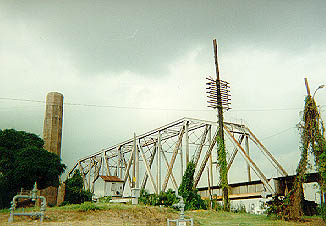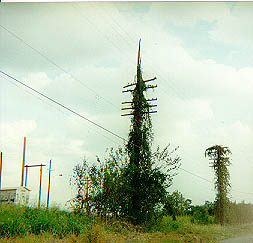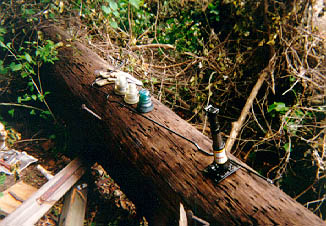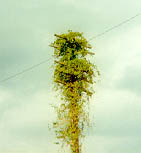Jewels in the Rough: The Turning Basin CD 213s
by Bob Machann (for Vicky and Melinda)
Reprinted from "Crown Jewels of the Wire", March 1998, page 37
Houston, Texas is an industrial city, especially on its east side. Major
streets and highways in the area are lined with factories, plants, refineries,
and mills. Serving these businesses are many miles of railroad track -- with lines.
Among these tracks was the former Southern Pacific main line that cut through
east Houston by the Turning Basin of the Houston Ship Channel. The track was
probably built in about the mid-1880s. The line following it housed both the
Western Union main trunk and Southern Pacific communication lines. Both the
track and the line are now gone. Among the insulators atop these poles, which
had been empty of wire since the 1970s, was a scattering of the CD 213 Hemingray
#43.
The line on the other side of town
It all began on a Saturday afternoon in April 1995. I met with fellow LSIC
member Marvin Suggs at a fast-food restaurant to trade insulators that day. I
was interested in some CD 136 B&O insulators he had recently found. Marvin
wanted to look at some CD 162 Hemingray 19s that I had. As a result of our
trade, I got a B&O with some great amber swirls. In turn, Marvin got a
Hemingray Blue #19.
For a few minutes afterwards, Marvin and I exchanged
information on lines we knew about. I told him about the Cane Junction line,
where the CD 162s had come from. We talked about several other lines, among
which was a line in east Houston that had poles loaded with CD 213s! This piqued
my curiosity, since I didn't have a CD 213 in my collection at the time. I was
vaguely familiar with the CD 213, since I had seen the picture of it in my
Milholland's book. Moreover, one would turn up every now and then on a sales
table at our local insulator show.
On one afternoon in late May, I had some time on my hands, so I decided to
take a look at the CD 213 line. I hopped into the Wild Injun (my Pontiac
Sunbird) and rode over to see the line. It was quite a long drive. I drove
through two industrial areas, past the original Ninfals restaurant, over a
bridge spanning a small trainyard, and through a sprawling neighborhood before I
reached West Hedrick Street. This street intersects Navigation in both north and
south directions. Marvin's line followed the street in both directions, too.
At
first glance, the line appeared to be mostly common stuff-aqua and clear
Hemingray #42 and pale aqua Whitall Tatums with a scattering of Hemingray #40s.
I began searching the portion south of Navigation. The first pole held nothing
particularly interesting, but on the second pole, there it was -- a lone aqua CD
213. It had a large chunk missing out of its skirt, but at least I knew that I
had to be close.
I continued to follow the line to a point where the line curves
in one direction and West Hedrick Street curves in another. In addition to the
#42s, a few of the poles had CD 145s on them, which I thought was interesting.
I
was having a good time exploring a new line in an area of Houston I had never
seen before. Even so, I was seeing very little in the way of CD 213s. Undaunted,
I turned the car around to check the stretch north of Navigation Boulevard.
On
the north side, the insulators were slightly different. There were still plenty
of Hemingray 42s and Tatum No.1 s, but the Hemingray No. 40 seemed more
plentiful on this side. I was amazed at what I saw as the end of the street
plunged towards Buffalo Bayou. Atop the pole on the corner, where West Hedrick
Street formed a T with J.W. Peavy Boulevard, sat six beautiful CD 213s! I drove
around neighboring Hidalgo Park and looked at the line again. This time, I
noticed that the last three poles along West Hedrick Street had CD 213s. One had
about three or four CD 213s, while another had eight or ten CD 213s. There was
one pole across Peavy Boulevard from Hidalgo Park, but it only had #42s. Across
the Buffalo Bayou, I could see a rather large, fat pole with three glass-loaded
arms on it.
I parked the car and did some walking. The tall Buffalo Bayou bridge
looks ominous from the street, but it has a mesh catwalk on it that makes
crossing easy. Although the original SP track was gone, two other tracks fed
into the bridge. After a careful check to ensure that no trains were coming, I
quickly crossed the bridge to look at the two nearest poles. The really thick pole that I had seen from Hidalgo Park sported seven or eight CD 213s.
The next pole, however, did not have any.

Medium B/W Image (62
kb)
Bayou Bridge
The rain, Hidalgo Park, and other things
June 29, 1995 was a rainy day in Houston. I wandered out that afternoon to
pick up a certified letter for me at the downtown post office. The letter wasn't
pretty. It was a notice informing me that I had not been approved for
second-year studies at the graduate school I had been attending earlier that
year.
I was already out in the rain, so I decided to salvage something of the
trip by taking a look at Marvin's line. I drove through the rain down Navigation
Boulevard, with the Pontiac's wipers slapping time to Martin Page's "In the
House of Stone and Light" on the radio. As I drove up West Hedrick Street
and approached Hidalgo Park, I saw something I wasn't sure if I liked. The pole
on the corner with the six CD 213 s was leaning drunkenly against a live
HL&P distribution pole.
Expulsion notice forgotten, I parked along Peavy
Boulevard by the park and examined the two poles from a safe distance. The
poles, the grass and vines growing around them, and the street were all wet with
rain. Remembering what happened to Carlos Jordan, I didn't want to get too
close.

Medium B/W image (43
kb)
Two poles, covered with growths of vines,
were found to have CD 213's on
them.
This was both a blessing and a curse. Fortunately, the distribution pole
had broken the fall of the old pole. If that pole had fallen full-force onto West Hedrick Street, the insulators naturally
would have been smashed into a million pieces. On the other hand, this would
create unwanted attention to the old poles. It seemed to me that someone in the
nearby neighborhood sooner or later would see this and report it.
I went home
and left a message about the situation with Marvin's girlfriend Michelle. Since
Marvin had wanted a CD 213 from that line, I figured that he was awaiting this
moment as much as I was. A few hours later, I went back to the Turning Basin. By
this time, HL&P crews were out to safely lower the old pole to the ground.
They were apparently having a tough time with the old pole, as they struggled
with it for more than half an hour. On its way down, the pole snagged a coaxial
cable and snapped it, darkening most of the streetlights on J.W. Peavy
Boulevard. In a squall of trumpet vine blossoms, an HL&P crewman struggled to
re-attach the cable to its pole.
When the pole was finally down, I noticed two
men wearing hardhats were carrying boxes with insulators inside a fenced area.
I approached the older of the two men and asked what would be done with the
insulators. He replied that all of the insulators were "railroad
property" and would be returned to them accordingly. He was wearing a
rather official-looking City of Houston hardhat, so I felt it was best not to
question him.

Medium B/W Image (99
kb)
Two Hemingray-45's and a CD 213.
Apparently, this fellow didn't try very hard to recover the "railroad
property." My message to Michelle paid off rather handsomely for both
Marvin and me. On the following Saturday, the two of them went to Hidalgo Park
and found two CD 213 s the laborer left behind. Not knowing this, I went back
over there myself on the following Monday to see if there was anything left. I
removed a Case bracket with excellent CD 1049 inserts. After that, I combed the
weeds around the crossarms for insulators, keeping a sharp eye out for water
moccasins. Instead of a snake, out popped a dirty Hemingray #45-and it began
rolling down the embankment towards the asphalt. I grabbed it and took it home
along with the Case bracket. That afternoon, I sat out on the balcony of my
apartment, sipping a root beer and admiring my finds. The pole was not a loss
after all.
I was glad to hear that Marvin found the CD 213s. Once again, we got
together for trading. Along with some common items that Marvin no longer wanted,
I acquired one of the CD 213s. It was heavily coated with soot like the #45 I
found, but it was in very nice condition.
Mr. Woodward cleaned the CD 213 and my
#45 for me. The cleaned CD 213 was gorgeous. When I looked at the cleaned #45, I
noticed that the insulator had a slight yellowish tint to it. It was a 1940 mold
set specimen, and Mr. Woodward suspected that this insulator could be made of
borosilicate glass. I was quite impressed with that. Before, I had thought that
it was just a plain #45.
Meanwhile across the Bayou ...
Except for a second 1940 #45 I found in February 1996, things were quiet
along West Hedrick Street. That changed one afternoon in early May 1996. I was
coming home from work when I took a detour past Hidalgo Park for a look at the
CD 213s. The poles along West Hedrick Street were in their usual positions, but
things were different on the other side of the bayou. The really thick pole by
the bayou was missing. Close to where it had stood was a large white sign. With
the help of binoculars, I could read the whitewashed wooden sign advising
vessels not to dock or weigh anchor at this site, as a natural gas pipeline was
about to go under construction there.
I jumped at the chance. on the following
Saturday, I went over to check the thick pole. After crossing the bridge, I
spotted the pole in the ditch. I slid down the sharp embankment, wrestled back
the vines, and examined the arms. One of the CD 213s had been smashed, but there
were two more within reach. I quickly unscrewed these and began searching for
more. While doing this, I accidentally kicked a third CD 213 out of the withered
leaves under the pole. When I was through, my packsack held three CD 213s, along
with about half a dozen CD 155s I stripped from the thick pole. There were two
more CD 213s stuck between the crossarms, which were snarled together when the
pole fell. I tried to saw through the crossarms to get them, but my saw blade
broke in two halfway through the first crossarm. I quit while I was ahead and
took home the insulators. Mr. Woodward later picked the stuck CD 213s.

Medium B/W Image (23
kb)
Pole with the broken CD 213 on it.
To me,
this was too good not to share. Although the CD 213s were filthy, I took a
couple up to Austin to the 1996 LSIC swap meet held at Jim Bates' house. In
spite of their appearance, the CD 213s traded like hotcakes! This was a
rewarding experience. On top of having the opportunity to remove CD 213s from a pole,
I felt better knowing that the CD 213s were in the hobby and not being bulldozed
into history by the pipeline project.
In the name of progress ...
Around Midnight on one evening in October 1997, I was driving around in east
Houston. I decided to drive past Hidalgo Park to check on the poles. As I drove
down J. W. Peavy Boulevard past Hidalgo Park, I discovered an insulator
collectors' nightmare.
GONE!! The tall, horribly weathered poles were nowhere to
be seen. The track bed and the thick weeds beside them were bulldozed flat. A
large City of Houston sign, complete with the names of Houston's City Council
members, stood by Navigation Boulevard. This sudden project was described only
as an "asphalt overlay." Hmmm ...
I came back the next day to get a
clearer view of what was going on. I drove the whole length of the street, but
not even a shard of an insulator remained. I gave the sign a begrudging look as
I began to head home. I won't forget the fun I had with this line. I must have
driven up and down West Hedrick Street a hundred times, watching those CD 213s.
Every heavy rain moved me to check the line for fallen poles, as did a January
1997 ice storm. I would like to thank Marvin for sharing this line with me.
Also, I would like to thank Mr. Woodward for historical information on the line,
as well as cleaning the insulators. The mystery remains: Why were the CD 213s
there and nowhere else on the line? Either the CD 213s were necessary to string
the communication lines across Buffalo Bayou, or perhaps the line construction
crew had a case of them that they wanted to get rid of. Either way, lines that
seem solid with common stuff do have dynamite items on them sometimes. Of
course, there are plenty more lines in east Houston, but those are other
projects.
This article was printed at the request of the author and with permission of
"Lone Star Lines ", monthly newsletter of the Lone Star Insulator
Club, in which it first appeared. Photographs provided by Bob Machann and N. R.
Woodward.
| 